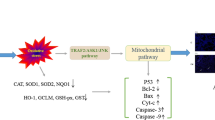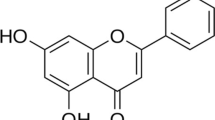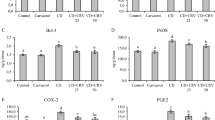Abstract
Cadmium (Cd) is a type of toxic substance, which widely exists in nature. However, the effect of Cd exposure on the toxicity of swine lungs and its underlying mechanism involved have not yet been reported. In our study, we divided swine into two groups, including a control group (C group) and Cd-exposed group. Swine in the C group were fed a basic diet, whereas swine in the Cd group were fed a 20 mg Cd/kg diet. Immunofluorescence, qRT-PCR, western blot analysis, and H&E staining were performed to detect necroptosis-related indicators. Our results found that after Cd exposure, Th1/Th2 imbalance occurred, miR-181-5p was down-regulated, TNF-α expression was increased, and the NF-κB/NLRP3 and JAK/STAT pathways and RIPK1/RIPK3/MLKL axis were activated. Furthermore, histopathological examination showed necrosis in swine lung after Cd exposure. Together, the above-mentioned results indicate that subacute Cd exposure is closely linked with necroptosis in swine lung. Our study provided evidence that Cd may act through miR-181-5p/TNF-α to induce necroptosis in swine lung. The findings of this study supplement the toxicological study of Cd and provide a reference for comparative medicine.




Similar content being viewed by others
Data Availability
The datasets used and/or analyzed during the current study are available from the corresponding author upon reasonable request.
References
Zhang S et al (2021) Geogenic enrichment of potentially toxic metals in agricultural soils derived from black shale in northwest Zhejiang, China: pathways to and risks from associated crops. Ecotoxicol Environ Saf 215:112102
Zhou Y et al (2020) Enrichment of cadmium in rice (Oryza sativa L.) grown under different exogenous pollution sources. Environ Sci Pollut Res Int 27(35):44249–44256
Zhao X et al (2021) Cadmium exposure induces TNF-α-mediated necroptosis via FPR2/TGF-β/NF-κB pathway in swine myocardium. Toxicology 453:152733
Hudson K, Belcher S, Cowley M (2019) Maternal cadmium exposure in the mouse leads to increased heart weight at birth and programs susceptibility to hypertension in adulthood. Sci Rep 9(1):13553
Rahmani Talatappeh N, Ranji N, Beigi Harchegani A (2021) The effect of N-acetyl cysteine on oxidative stress and apoptosis in the liver tissue of rats exposed to cadmium. Arch Environ Occup Health 2021:1–8
Yu Z et al (2021) Puerarin induces Nrf2 as a cytoprotective mechanism to prevent cadmium-induced autophagy inhibition and NLRP3 inflammasome activation in AML12 hepatic cells. J Inorg Biochem 217:111389
Madboli A, Seif M (2021) Immunohistochemical, histopathological, and biochemical studies of the NF-ҡB P65 marker in rat ovaries experimentally intoxicated by cadmium and the protective effect of the purslane plant extract. Environ Sci Pollut Res Int 28(14):17613–17626
Ni H et al (2020) The role of zinc chelate of hydroxy analogue of methionine in cadmium toxicity: effects on cadmium absorption on intestinal health in piglets. Animal 14(7):1382–1391
Flegal K et al (1980) Dietary selenium and cadmium interrelationships in growing swine. J Nutr 110(6):1255–1261
Zhang W et al (2017) Cadmium exposure in newborn rats ovary induces developmental disorders of primordial follicles and the differential expression of SCF/c-kit gene. Toxicol Lett 280:20–28
Straif K et al (2009) A review of human carcinogens–Part C: metals, arsenic, dusts, and fibres. Lancet Oncol 10(5):453–454
Tanwar V et al (2019) Cadmium exposure upregulates SNAIL through miR-30 repression in human lung epithelial cells. Toxicol Appl Pharmacol 373:1–9
Kiran Kumar K et al (2016) Cadmium induces oxidative stress and apoptosis in lung epithelial cells. Toxicol Mech Methods 26(9):658–666
Jiang D et al (2021) The susceptibility of Lymantria dispar larvae to Beauveria bassiana under Cd stress: a multi-omics study. Environ Pollut (Barking, Essex: 1987) 276:116740
Höckner M et al (2020) Cadmium-related effects on cellular immunity comprises altered metabolism in earthworm coelomocytes. Int J Mol Sci 21(2)
Templeton D, Liu Y (2010) Multiple roles of cadmium in cell death and survival. Chem Biol Interact 188(2):267–275
Li J et al (2021) Selenium deficiency induced apoptosis via mitochondrial pathway caused by Oxidative Stress in porcine gastric tissues. Research in veterinary science
Li Z et al (2019) The interaction of Atg4B and Bcl-2 plays an important role in Cd-induced crosstalk between apoptosis and autophagy through disassociation of Bcl-2-Beclin1 in A549 cells. Free Radical Biol Med 130:576–591
Zhang J et al (2020) Cadmium-induced oxidative stress promotes apoptosis and necrosis through the regulation of the miR-216a-PI3K/AKT axis in common carp lymphocytes and antagonized by selenium. Chemosphere 258:127341
Che L et al (2021) Mitochondrial redox-driven mitofusin 2 S-glutathionylation promotes neuronal necroptosis via disrupting ER-mitochondria crosstalk in cadmium-induced neurotoxicity. Chemosphere 262:127878
Wang Y et al (2020) Protective effects of selenium yeast against cadmium-induced necroptosis via inhibition of oxidative stress and MAPK pathway in chicken liver. Ecotoxicol Environ Saf 206:111329
Huang H et al (2007) CD4+ Th1 cells promote CD8+ Tc1 cell survival, memory response, tumor localization and therapy by targeted delivery of interleukin 2 via acquired pMHC I complexes. Immunology 120(2):148–159
Chen M et al (2019) Hydrogen sulfide exposure triggers chicken trachea inflammatory injury through oxidative stress-mediated FOS/IL8 signaling. J Hazard Mater 368:243–254
Goyal T et al (2021) Estimation of lymphocyte subsets and cytokine levels in workers occupationally exposed to cadmium. Journal of trace elements in medicine and biology : organ of the Society for Minerals and Trace Elements (GMS) 64:126681
Li Q et al (2021) Regulation of Th1/Th2 and Th17/Treg by pDC/mDC imbalance in primary immune thrombocytopenia. Experimental Biology and Medicine (Maywood, N.J.):15353702211009787
Xie Y et al (2020) Gut epithelial TSC1/mTOR controls RIPK3-dependent necroptosis in intestinal inflammation and cancer. J Clin Investig 130(4):2111–2128
Koike A, Hanatani M, Fujimori K (2019) Pan-caspase inhibitors induce necroptosis via ROS-mediated activation of mixed lineage kinase domain-like protein and p38 in classically activated macrophages. Exp Cell Res 380(2):171–179
Tam V et al (2020) PPARα exacerbates necroptosis, leading to increased mortality in postinfluenza bacterial superinfection. Proc Natl Acad Sci USA 117(27):15789–15798
Ishfaq M et al (2019) Baicalin ameliorates oxidative stress and apoptosis by restoring mitochondrial dynamics in the spleen of chickens via the opposite modulation of NF-κB and Nrf2/HO-1 signaling pathway during Mycoplasma gallisepticum infection. Poult Sci 98(12):6296–6310
Ghorbani S et al (2017) miR-181 interacts with signaling adaptor molecule DENN/MADD and enhances TNF-induced cell death. PloS one 12(3):e0174368
Cui Y et al (2019) Atrazine induces necroptosis by miR-181-5p targeting inflammation and glycometabolism in carp lymphocytes. Fish Shellfish Immunol 94:730–738
Escate R et al (2018) miR-505-3p controls chemokine receptor up-regulation in macrophages: role in familial hypercholesterolemia. FASEB J 32(2):601–612
Yao Y et al (2021) Subacute cadmium exposure promotes M1 macrophage polarization through oxidative stress-evoked inflammatory response and induces porcine adrenal fibrosis. Toxicology 2021:152899
Zhang Y et al (2021) Cadmium induced inflammation and apoptosis of porcine epididymis via activating RAF1/MEK/ERK and NF-κB pathways. Toxicol Appl Pharmacol 415:115449
Yin K et al (2020) Antagonistic effect of selenium on lead-induced neutrophil apoptosis in chickens via miR-16-5p targeting of PiK3R1 and IGF1R. Chemosphere 246:125794
Li X et al (2021) New insights into crosstalk between apoptosis and necroptosis co-induced by chlorothalonil and imidacloprid in Ctenopharyngodon idellus kidney cells. Sci Total Environ 780:146591
Jiayong Z et al (2020) The antagonistic effect of selenium on lead-induced necroptosis via MAPK/NF-κB pathway and HSPs activation in the chicken spleen. Ecotoxicol Environ Saf 204:111049
Xu X et al (2021) Establishment and characterization of a gill cell line from pearl gentian grouper (Epinephelus lanceolatus♂×Epinephelus fuscoguttatus♀) and its application in cadmium toxicology. Ecotoxicol Environ Saf 208:111614
Yang G et al (2019) Serum cadmium and lead, current wheeze, and lung function in a nationwide study of adults in the United States. J Allergy Clin Immunol 7(8):2653-2660.e3
Xin C et al (2020) Astilbin protects chicken peripheral blood lymphocytes from cadmium-induced necroptosis via oxidative stress and the PI3K/Akt pathway. Ecotoxicol Environ Saf 190:110064
Zhang Y et al (2018) Cd induces G2/M cell cycle arrest by up-regulating miR-133b via directly targeting PPP2R2D in L02 hepatocytes. Metallomics Integr Biomet Sci 10(10):1510–1523
Sun Y et al (2021) C-myc promotes miR-92a-2-5p transcription in rat ovarian granulosa cells after cadmium exposure. Toxicol Appl Pharmacol 421:115536
Tang X et al (2020) The miR-155 regulates cytokines expression by SOSC1 signal pathways of fish in vitro and in vivo. Fish Shellfish Immunol 106:28–35
Han S et al (2021) Lactobacillus rhamnosus HDB1258 modulates gut microbiota-mediated immune response in mice with or without lipopolysaccharide-induced systemic inflammation. BMC Microbiol 21(1):146
Xu L et al (2019) Chemokine and cytokine cascade caused by skewing of the Th1-Th2 balance is associated with high intracranial pressure in HIV-associated cryptococcal meningitis. Mediat Inflamm 2019:2053958
Liang Z, Tang F (2020) The potency of lncRNA MALAT1/miR-155/CTLA4 axis in altering Th1/Th2 balance of asthma. Bioscie Rep 40(2)
Xu S et al (2021) Pig lung fibrosis is active in the subacute CdCl exposure model and exerts cumulative toxicity through the M1/M2 imbalance. Ecotoxicol Environ Saf 225:112757
Cui W et al (2021) Cadmium exposure activates the PI3K/AKT signaling pathway through miRNA-21, induces an increase in M1 polarization of macrophages, and leads to fibrosis of pig liver tissue. Ecotoxicol Environ Saf 228:113015
Zhang Y et al (2021) Selenium deficiency induced necroptosis, Th1/Th2 imbalance, and inflammatory responses in swine ileum. J Cell Physiol 236(1):222–234
Guo M et al (2019) Triggering MSR1 promotes JNK-mediated inflammation in IL-4-activated macrophages. EMBO J 38(11)
Jiang K et al (2021) A negative feedback loop involving NF-κB/TIR8 regulates IL-1β-induced epithelial- myofibroblast transdifferentiation in human tubular cells. J Cell Commun Signal 15(3):393–403
Zhou J et al (2002) A role for NF-kappa B activation in perforin expression of NK cells upon IL-2 receptor signaling. J Immunol (Baltimore, Md. : 1950) 169(3):1319–25
Qin Y et al (2019) Interferon gamma inhibits the differentiation of mouse adult liver and bone marrow hematopoietic stem cells by inhibiting the activation of notch signaling. Stem Cell Res Ther 10(1):210
Devin A et al (2001) The alpha and beta subunits of IkappaB kinase (IKK) mediate TRAF2-dependent IKK recruitment to tumor necrosis factor (TNF) receptor 1 in response to TNF. Mol Cell Biol 21(12):3986–3994
Jackson-Bernitsas D et al (2007) Evidence that TNF-TNFR1-TRADD-TRAF2-RIP-TAK1-IKK pathway mediates constitutive NF-kappaB activation and proliferation in human head and neck squamous cell carcinoma. Oncogene 26(10):1385–1397
Galluzzi L et al (2011) Programmed necrosis from molecules to health and disease. Int Rev Cell Mol Biol 289:1–35
Li J et al (2012) The RIP1/RIP3 necrosome forms a functional amyloid signaling complex required for programmed necrosis. Cell 150(2):339–350
Cai Z et al (2014) Plasma membrane translocation of trimerized MLKL protein is required for TNF-induced necroptosis. Nat Cell Biol 16(1):55–65
Habbeddine M et al (2017) Receptor activator of NF-κB orchestrates activation of antiviral memory CD8 T cells in the spleen marginal zone. Cell Rep 21(9):2515–2527
Acknowledgements
Supported by China Agriculture Research System of MOF and MARA. The authors extend their sincere thanks to the members of the veterinary internal medicine laboratory and Key Laboratory for Laboratory Animals at the College of Veterinary Medicine, Northeast Agricultural University.
Author information
Authors and Affiliations
Contributions
Wenyue Zhang: investigation; formal analysis; writing—original draft. Xinyue Sun: draft layout, visualization. Xu Shi: software, investigation. Xue Qi: software. Hongjin Lin: conceptualization; resources; supervision; validation; writing—review and editing.
Corresponding author
Ethics declarations
Ethical approval
All other authors have read the manuscript and have agreed to submit it in its current form for consideration for publication in the Journal.
Additional information
Publisher's Note
Springer Nature remains neutral with regard to jurisdictional claims in published maps and institutional affiliations.
Rights and permissions
About this article
Cite this article
Zhang, W., Sun, X., Shi, X. et al. Subacute Cadmium Exposure Induces Necroptosis in Swine Lung via Influencing Th1/Th2 Balance. Biol Trace Elem Res 201, 220–228 (2023). https://doi.org/10.1007/s12011-022-03133-6
Received:
Accepted:
Published:
Issue Date:
DOI: https://doi.org/10.1007/s12011-022-03133-6




